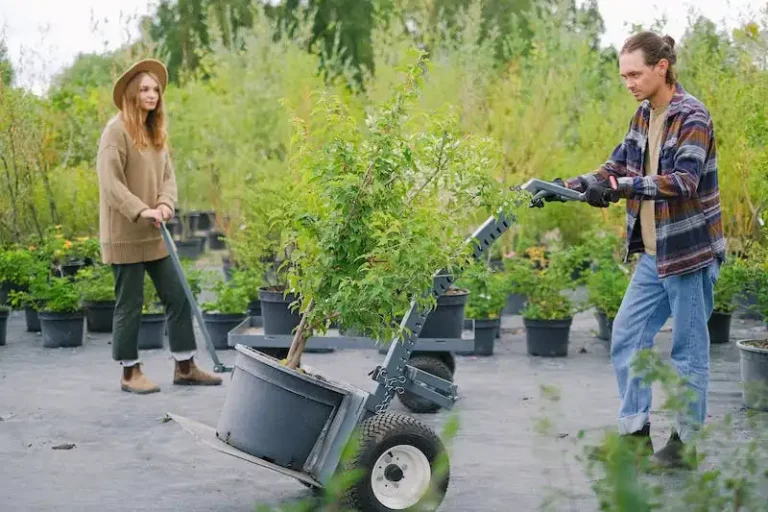If you’re looking to add a splash of tropical beauty to your outdoor space, growing hibiscus in pots might be just the thing for you. Hibiscus, or Hibiscus rosa-sinensis, is a stunning flowering plant that can thrive in containers while also adding a touch of exotic beauty to any patio or balcony.
One of the key ways to ensure that your hibiscus plants thrive is by making sure they are in the right location. Hibiscus plants love bright, sunny spots, so finding a sunny location for your potted hibiscus is essential. Choose a spot that receives at least six hours of direct sunlight each day.
When it comes to potting hibiscus, it’s important to choose the right container for your plant. Consider the size of your plant and choose a pot that is slightly larger than the root ball. Make sure the pot has drainage holes to prevent waterlogged roots.
Once your hibiscus is planted in its container, it’s important to provide it with the proper care. Water your hibiscus regularly, keeping the soil evenly moist but not soggy. Hibiscus plants also benefit from regular fertilization, so consider using a slow-release fertilizer to provide the necessary nutrients.
During the winter months, hibiscus plants may need some extra care to survive. If you live in a colder climate, consider bringing your potted hibiscus indoors for the winter. Place it in a sunny location and continue to water and fertilize it as needed.
Pruning is another important aspect of caring for your potted hibiscus. Regularly prune your plant to remove dead or damaged branches, and encourage branching and bushier growth. Pruning can also help shape your hibiscus plant and keep it looking neat and tidy.
By following these tips and providing the right care, your hibiscus plant will reward you with abundant blooms and healthy growth. So get ready to enjoy the beauty of hibiscus in your very own potted garden!
Source: “Growing Hibiscus In Pots” by Home Gardening Tips
How to grow hibiscus
Growing hibiscus in pots can be a great way to have these beautiful flowers in your garden, no matter where you live. While hibiscus plants need the right conditions to thrive, they can be grown successfully in containers with the proper care.
To start, hibiscus plants require well-drained soil. Use a high-quality potting mix with good drainage to ensure the roots stay healthy. It’s also important to choose a container with drainage holes to prevent water from accumulating around the roots.
Hibiscus plants are native to tropical and subtropical regions, so they need plenty of sunlight to grow. Place your potted hibiscus in a sunny location where it can receive at least six hours of direct sunlight per day.
When planting hibiscus in pots, it’s a good idea to add composted organic matter to the soil. This will help improve the soil’s fertility and provide essential nutrients for the plant’s growth.
While hibiscus plants are generally low-maintenance, they still require regular care. Be sure to water your hibiscus regularly, keeping the soil consistently moist. However, be careful not to overwater, as this can lead to root rot. It’s also important to fertilize your hibiscus plants every few weeks during the growing season to provide them with the necessary nutrition.
If you live in an area with frost, it’s best to bring your potted hibiscus indoors or provide them with a sheltered location once the temperatures drop. Hibiscus plants are sensitive to cold and their leaves and branches can be damaged by frost.
Pruning can be essential for keeping your hibiscus plants healthy and encouraging new growth. Prune your hibiscus in early winter to remove any dead or damaged branches. This will help promote a more compact and attractive plant.
Another problem-solving tip for growing hibiscus in pots is to be prepared for smaller-sized plants. While hibiscus can grow quite large in their native environment, they are often smaller when planted in containers. This is due to the restricted root space.
If you’re looking to buy hibiscus plants for your container garden, make sure to choose a suitable variety. Some hibiscus plants are better suited for container cultivation, as they have a more compact growth habit.
In conclusion, growing hibiscus in pots is a wonderful way to add a tropical touch to your garden. With the right care and attention, you can enjoy the beauty of hibiscus flowers in containers. Just make sure to provide them with the proper sunlight, well-drained soil, and regular care, and they will thrive for years to come!
Where to grow hibiscus
When it comes to growing hibiscus, finding the right location is crucial. Hibiscus plants thrive in sheltered areas, so it is best to find a spot that offers the most protection from strong winds and harsh weather conditions.
If you are planting hibiscus in a pot, make sure to choose a container that is large enough to accommodate the plant’s root system. The pot should have good drainage to prevent water logging, as hibiscus plants do not tolerate soggy soil.
For those living in colder regions where frost is common, it is important to be prepared. Hibiscus plants are not cold-hardy, so they will not survive freezing temperatures. If you want to keep your hibiscus outdoors all year round, consider buying a hardy variety or bring it indoors during the winter.
When potting hibiscus, think about the quality of the soil you are using. A well-drained, nutrient-rich medium is essential. It is recommended to use a mixture of good-quality potting soil and organic compost to provide adequate drainage and nutrition for the plant.
When it comes to fertilizers, hibiscus plants require regular feeding to support their growth. Slow-release fertilizers are a good option as they provide a steady supply of nutrients over a long period of time. Additionally, a spray of liquid fertilizer once or twice a month can be beneficial for promoting blooming.
Keep a watchful eye on your hibiscus plant, especially during the blooming season. Regularly check for pests or disease and take appropriate action if needed. Remove any dead or damaged branches to encourage new growth and maintain a healthy plant.
Choosing the right location for your hibiscus plant is crucial to its overall health and growth. By providing the right conditions, proper nutrition, and regular care, your hibiscus plant will thrive and reward you with beautiful blooms year after year.
How to care for hibiscus
When it comes to growing hibiscus in containers, it’s important to know how to properly care for them to ensure their health and growth. Here are some essential tips:
1. Choosing the right container: Select a well-drained potting medium and a container with good drainage. Make sure the pot is large enough to accommodate the roots and provide enough room for growth.
2. Positioning the hibiscus: Place the potted hibiscus in a sunny location, preferably with shade during the hottest part of the day. This will help prevent wilting and sunburn during summer.
3. Watering: Water the hibiscus plants thoroughly, allowing the soil to dry out slightly between waterings. Avoid overwatering, as this can lead to root rot.
4. Fertilizers and nutrition: Use a slow-release fertilizer specifically formulated for hibiscus plants. Feed the hibiscus plants once in early spring and again in early summer for optimal nutrition and growth.
5. Pruning: Prune the hibiscus plants to maintain their shape and encourage bushier growth. Remove any weak or dead branches to promote healthy growth.
6. Winter care: If you live in a colder climate, bring the potted hibiscus indoors during winter or provide them with protection. Keep them in a cool location with indirect sunlight and reduce watering frequency.
7. Buying quality plants: When buying hibiscus plants, make sure to choose healthy and strong specimens. Avoid plants with wilting leaves or signs of pests or diseases.
By following these care tips, you can ensure that your hibiscus plants thrive and bring beauty to your garden or indoor space. Take note of their specific needs and adjust your care routine accordingly. Happy growing!
Growing hibiscus problem-solving
When it comes to growing hibiscus in pots, there may be times when you encounter certain problems. Fortunately, most of these issues can be addressed with proper care and attention. Here are some common problems that you may face and what you can do to solve them:
1. Frost damage:
If your hibiscus is potted, it may be more susceptible to frost damage. To prevent this, consider moving your plant to a sheltered location or bring it indoors during the colder months.
2. Lack of growth:
If your hibiscus is not growing as well as you’d like it to, check the quality of the soil and the level of nutrients it receives. Make sure the potting mix is well-drained and filled with the necessary nutrients for optimal growth. Consider buying fertilizers or plant hormones to boost growth.
3. Leaf discoloration:
If your hibiscus leaves are turning yellow or showing other signs of discoloration, it may be due to overwatering or a lack of nutrients. Adjust your watering schedule and ensure the plant gets enough nutrition.
4. Trunk or branches break easily:
If the trunk or branches of your hibiscus seem weak and break easily, it could be a sign of improper care or a lack of support. Consider staking or providing support to help the plant grow upright and prevent breakage.
5. Lack of blooming:
If your hibiscus is not blooming as much as you’d like, it could be due to several factors, such as too much shade, improper positioning, or a lack of nutrients. Ensure your plant receives enough sunlight, is positioned correctly, and gets the necessary nutrition for blooming.
6. Pest infestation:
If you notice pests or insects on your hibiscus plant, consider using a suitable insecticidal spray or other pest control products. Regularly inspect your plant for signs of infestation and take appropriate measures to keep it pest-free.
7. Winter care:
When winter comes, hibiscus in containers may struggle to survive the cold temperatures. Ensure your plant is well-prepared for winter by providing protective measures such as wrapping or insulation. Alternatively, consider bringing the plant indoors for the winter.
By addressing these problem-solving tips, you can help your hibiscus plant thrive and ensure it looks healthy and beautiful for years to come.




